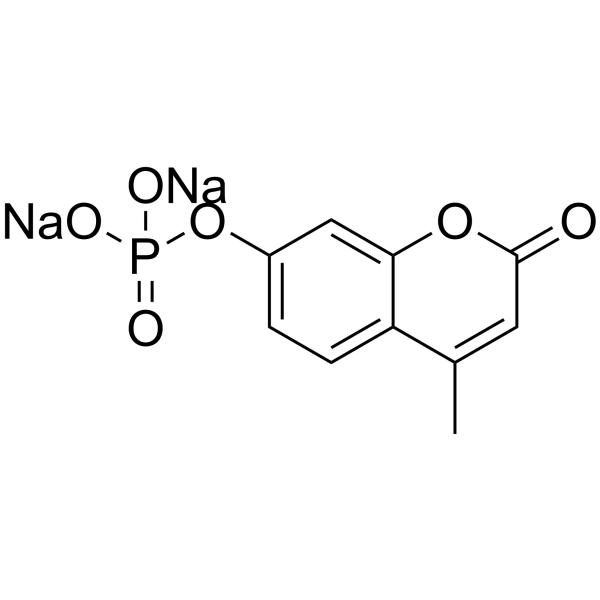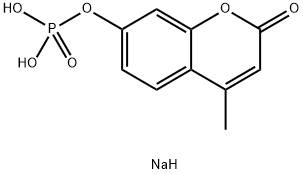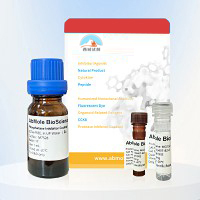4-甲基伞形酮磷酸酯 二钠盐 ,disodium 7-hydroxy-4-methylcoumarinyl phosphate ,≥98% (TLC)
产品编号:SIGMA-M8168| CAS NO:22919-26-2| 分子式:C10H7Na2O6P| 分子量:300.1123
4-甲基伞形花序基磷酸酯(4-MUP)二钠是一种阴离子有机磷酸盐,是一种酸性和碱性磷酸酶荧光底物。4-甲基延胡索磷酸二钠也是一种神经毒剂模拟物。
本网站销售的所有产品仅用于工业应用或者科学研究等非医疗目的,不可用于人类或动物的临床诊断或者治疗,非药用,非食用,
| 产品名称 | 4-甲基伞形酮磷酸酯 二钠盐 | ||||||||||||||||
|---|---|---|---|---|---|---|---|---|---|---|---|---|---|---|---|---|---|
| 英文名称 | disodium 7-hydroxy-4-methylcoumarinyl phosphate | ||||||||||||||||
| CAS编号 | 22919-26-2 | ||||||||||||||||
| 产品描述 | 4-甲基伞形花序基磷酸酯(4-MUP)二钠是一种阴离子有机磷酸盐,是一种酸性和碱性磷酸酶荧光底物。4-甲基延胡索磷酸二钠也是一种神经毒剂模拟物。 | ||||||||||||||||
| 产品沸点 | 511.4ºC at 760 mmHg | ||||||||||||||||
| 产品闪点 | 263.1ºC | ||||||||||||||||
| 精确质量 | 299.977570 | ||||||||||||||||
| PSA | 112.44000 | ||||||||||||||||
| LogP | 2.44930 | ||||||||||||||||
| 外观性状 | 白色粉末 | ||||||||||||||||
| 蒸气压 | 2.79E-11mmHg at 25°C | ||||||||||||||||
| 溶解性数据 | In Vitro: H2O : 20.83 mg/mL (81.32 mM; Need ultrasonic) 配制储备液
* 请根据产品在不同溶剂中的溶解度选择合适的溶剂配制储备液;一旦配成溶液,请分装保存,避免反复冻融造成的产品失效。 In Vivo: 请根据您的实验动物和给药方式选择适当的溶解方案。以下溶解方案都请先按照 In Vitro 方式配制澄清的储备液,再依次添加助溶剂: ——为保证实验结果的可靠性,澄清的储备液可以根据储存条件,适当保存;体内实验的工作液,建议您现用现配,当天使用; 以下溶剂前显示的百分比是指该溶剂在您配制终溶液中的体积占比;如在配制过程中出现沉淀、析出现象,可以通过加热和/或超声的方式助溶
| ||||||||||||||||
| 体外研究 | 指南(以下是我们推荐的方案。该方案仅提供指南,应根据您的具体需要进行修改)。血清酸性磷酸酶测定:1.制备100μL含有以下试剂的溶液:5.0μL血清酶,50μL 4-甲基伞形草酰磷酸(5.0 mM),10μL 1.0 M缓冲液,pH 6.0。2.添加以下试剂(最终浓度)20 mM酒石酸钠(HY-128476),15 mM氟化钠(HY-B1766),3000 mM 2-巯基乙醇,4 mM 1,10菲咯啉(HY-W004544)、6 mM 8-喹啉醇(HY-B1005)、6 m M 8-羟基-5-喹啉磺酸、45 mM EDTA(HY-Y0682)和6 mM EGTA(HY-D0861)。3.在37℃下培养反应混合物15分钟,并通过添加2.9 mL 0.1 M氢氧化铵/甘氨酸缓冲液(pH 10.5)终止。4.彻底混合样品并用荧光计测定荧光。 | ||||||||||||||||
| 稳定性 | 遵照规定使用和储存则不会分解。 | ||||||||||||||||
| 储存条件 | 储存条件: -20°C 运输方式: 冰袋运输,根据产品的不同,可能会有相应调整。 |
相关文档
化学品安全说明书(MSDS)
下载MSDS质检证书(COA)
相关产品
| 个人防护装备 | Eyeshields;Gloves;type N95 (US);type P1 (EN143) respirator filter |
|---|---|
| 安全声明 (欧洲) | S22-S24/25 |
| 危险品运输编码 | NONH for all modes of transport |
| WGK德国 | 3 |
| 海关编码 | 2932209090 |
Synonym:None Known Section 2 - COMPOSITION, INFORMATION ON INGREDIENTS
Risk Phrases: None Listed. Section 3 - HAZARDS IDENTIFICATION EMERGENCY OVERVIEW
Light sensitive.Moisture sensitive.The toxicological properties of this material have not been fully investigated. Potential Health Effects Eye: May cause eye irritation. Skin: May cause skin irritation. Ingestion: May cause irritation of the digestive tract. The toxicological properties of this substance have not been fully investigated. Inhalation: May cause respiratory tract irritation. The toxicological properties of this substance have not been fully investigated. Chronic: No information found. Section 4 - FIRST AID MEASURES Eyes: In case of contact, immediately flush eyes with plenty of water for at least 15 minutes. Get medical aid. Skin: In case of contact, flush skin with plenty of water. Remove contaminated clothing and shoes. Get medical aid if irritation develops and persists. Wash clothing before reuse. Ingestion: If swallowed, do not induce vomiting unless directed to do so by medical personnel. Never give anything by mouth to an unconscious person. Get medical aid. Inhalation: If inhaled, remove to fresh air. If not breathing, give artificial respiration. If breathing is difficult, give oxygen. Get medical aid. Notes to Physician: Treat symptomatically and supportively. Section 5 - FIRE FIGHTING MEASURES General Information: As in any fire, wear a self-contained breathing apparatus in pressure-demand, MSHA/NIOSH (approved or equivalent), and full protective gear. During a fire, irritating and highly toxic gases may be generated by thermal decomposition or combustion. Extinguishing Media: Use water spray, dry chemical, carbon dioxide, or chemical foam. Section 6 - ACCIDENTAL RELEASE MEASURES General Information: Use proper personal protective equipment as indicated in Section 8. Spills/Leaks: Vacuum or sweep up material and place into a suitable disposal container. Clean up spills immediately, observing precautions in the Protective Equipment section. Avoid generating dusty conditions. Provide ventilation. Section 7 - HANDLING and STORAGE Handling: Wash thoroughly after handling. Use with adequate ventilation. Minimize dust generation and accumulation. Avoid breathing dust, vapor, mist, or gas. Avoid contact with eyes, skin, and clothing. Keep container tightly closed. Avoid ingestion and inhalation. Store protected from light. Keep from contact with moist air and steam. Storage: Store in a tightly closed container. Keep refrigerated. (Store below 4C/39F.) Store protected from light. Section 8 - EXPOSURE CONTROLS, PERSONAL PROTECTION Engineering Controls: Facilities storing or utilizing this material should be equipped with an eyewash facility and a safety shower. Use adequate ventilation to keep airborne concentrations low. Exposure Limits CAS# 22919-26-2: Personal Protective Equipment Eyes: Wear appropriate protective eyeglasses or chemical safety goggles as described by OSHA's eye and face protection regulations in 29 CFR 1910.133 or European Standard EN166. Skin: Wear appropriate protective gloves to prevent skin exposure. Clothing: Wear appropriate protective clothing to prevent skin exposure. Respirators: Follow the OSHA respirator regulations found in 29 CFR 1910.134 or European Standard EN 149. Use a NIOSH/MSHA or European Standard EN 149 approved respirator if exposure limits are exceeded or if irritation or other symptoms are experienced. Section 9 - PHYSICAL AND CHEMICAL PROPERTIES Physical State: Crystalline powder Color: white to off-white Odor: odorless pH: Not available. Vapor Pressure: Not available. Viscosity: Not available. Boiling Point: Not available. Freezing/Melting Point: Not available. Autoignition Temperature: Not available. Flash Point: Not available. Explosion Limits, lower: Not available. Explosion Limits, upper: Not available. Decomposition Temperature: Solubility in water: soluble in water Specific Gravity/Density: Molecular Formula: C10H7Na2O6P.3H2O Molecular Weight: 354.16 Section 10 - STABILITY AND REACTIVITY Chemical Stability: Stable under normal temperatures and pressures. Moisture sensitive. Light sensitive. Conditions to Avoid: Light, excess heat, exposure to moist air or water. Incompatibilities with Other Materials: Strong oxidizing agents. Hazardous Decomposition Products: Carbon monoxide, oxides of phosphorus, carbon dioxide. Hazardous Polymerization: Will not occur. Section 11 - TOXICOLOGICAL INFORMATION RTECS#: CAS# 22919-26-2 unlisted. LD50/LC50: Not available. Carcinogenicity: 4-Methylumbelliferylphosphate disodium salt trihydrate - Not listed by ACGIH, IARC, or NTP. Section 12 - ECOLOGICAL INFORMATION Section 13 - DISPOSAL CONSIDERATIONS Dispose of in a manner consistent with federal, state, and local regulations. Section 14 - TRANSPORT INFORMATION IATA Not regulated as a hazardous material. IMO Not regulated as a hazardous material. RID/ADR Not regulated as a hazardous material. Section 15 - REGULATORY INFORMATION European/International Regulations European Labeling in Accordance with EC Directives Hazard Symbols: Not available. Risk Phrases: Safety Phrases: S 24/25 Avoid contact with skin and eyes. WGK (Water Danger/Protection) CAS# 22919-26-2: No information available. Canada CAS# 22919-26-2 is listed on Canada's DSL List. CAS# 22919-26-2 is not listed on Canada's Ingredient Disclosure List. US FEDERAL TSCA CAS# 22919-26-2 is listed on the TSCA inventory. SECTION 16 - ADDITIONAL INFORMATION N/A |









 浙公网安备 33010802013016号
浙公网安备 33010802013016号